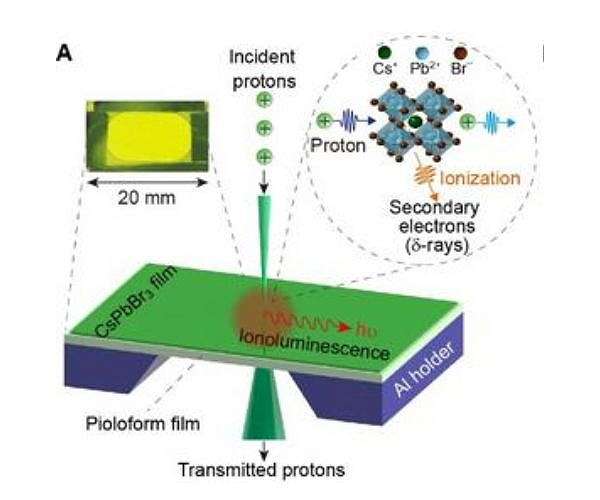
NUS develops perovskite nanocrystal scintillators for precise single-proton detection
by Simon Mansfield
Sydney, Australia (SPX) Feb 02, 2024
In a significant leap forward for particle radiation detection technology, researchers from the National University of Singapore (NUS) have introduced an innovative transmissive thin scintillator crafted from perovskite nanocrystals. This novel device is engineered for the real-time tracking and counting of single protons, marking a considerable advancement in the field of particle detection.
At the heart of this breakthrough is the scintillator’s exceptional sensitivity, attributed to biexcitonic radiative emission generated through proton-induced upconversion and impact ionization. This technological innovation is poised to revolutionize a range of scientific and technological domains, including fundamental physics, quantum technology, deep space exploration, and notably, proton cancer therapy.
The quest for precise dose control in proton therapy has catalyzed extensive research into advanced proton detectors. The NUS team’s development stands out by addressing a critical challenge in the field: the need for real-time proton irradiation with single-proton counting accuracy. Unlike traditional particle detectors, which are hampered by their bulkiness or insufficient sensitivity, the NUS-developed scintillator combines ultrathin construction with unparalleled sensitivity.
Led by Professor Liu Xiaogang from the NUS Department of Chemistry and Associate Professor Andrew Bettiol from the NUS Department of Physics, the research team has showcased a thin-film transmissive scintillator that significantly outperforms existing solutions. With a light yield approximately double that of commercially available BC-400 plastic thin-film scintillators and ten times greater than conventional bulk scintillators like LYSO:Ce, BGO, and YAG:Ce crystals, this innovation represents a major step forward in the detection and imaging of single protons.
The scintillators, with a mere thickness of about 5 um, achieve a detection limit of 7 protons per second- a sensitivity that is several orders of magnitude lower than the counting rates deemed clinically relevant. This capability is crucial for applications where precise detection and imaging are paramount.
Moreover, the team has put forward a novel theory regarding the scintillation mechanisms induced by protons in CsPbBr3 nanocrystals, providing significant insights into the fundamental processes underpinning proton scintillation. This understanding is instrumental in harnessing the full potential of perovskite nanocrystals in particle radiation detection.
Utilizing the enhanced sensitivity and fast response time (~336 ps) of these scintillators, the researchers have demonstrated their utility in applications ranging from single-proton tracing and real-time patterned irradiation to super-resolution proton imaging. Impressively, the study achieved a spatial resolution of sub-40 nm for proton imaging, heralding new possibilities for materials characterization, medical imaging, and scientific research.
Professor Liu emphasized the transformative impact of their work, noting, “The breakthrough presented in this work would be of considerable interest to particle radiation detection communities, offering both fundamental insights into new mechanisms of proton scintillation and technical advances in groundbreaking single-ion detection sensitivity using ultrathin proton-transmissive scintillators. In particular, these CsPbBr3 nanocrystal scintillators hold overwhelming promise for advancing detection technology in proton therapy and proton radiography.”
Published in the journal Nature Materials, this research not only contributes to the advancement of detection technologies but also underscores the potential of perovskite nanocrystals in revolutionizing the field. As the scientific community continues to explore the applications of this novel technology, the findings from the NUS team offer a promising path towards improved diagnostics, therapy, and understanding of particle physics.
Research Report:Real-time single-proton counting with transmissive perovskite nanocrystal scintillators
Related Links
National University of Singapore
All About Solar Energy at SolarDaily.com
- SEO Powered Content & PR Distribution. Get Amplified Today.
- PlatoData.Network Vertical Generative Ai. Empower Yourself. Access Here.
- PlatoAiStream. Web3 Intelligence. Knowledge Amplified. Access Here.
- PlatoESG. Carbon, CleanTech, Energy, Environment, Solar, Waste Management. Access Here.
- PlatoHealth. Biotech and Clinical Trials Intelligence. Access Here.
- Source: https://www.solardaily.com/reports/NUS_develops_perovskite_nanocrystal_scintillators_for_precise_single_proton_detection_999.html



